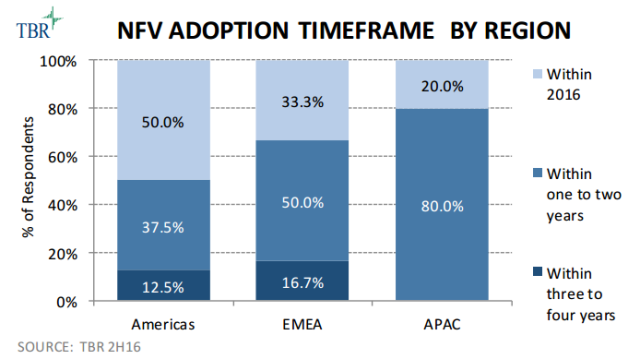
TBR, a leading research agency, has revealed the forecast on NFV investment plans by telecom operators across the world.
Initial large-scale commercial deployments drive optimism around NFV and SDN, with most telecom providers expecting adoption within two years.
Most Tier 1 telecom providers anticipate their organizations will adopt NFV and SDN technologies within two years. This optimism is fueled by positive business results from large-scale commercial deployments of business network services from AT&T and Orange.
“Tier 1 service providers are proving the business case for NFV / SDN by delivering cost savings and incremental revenue through early deployments,” said TBR Telecom Executive Analyst Michael SullivanTrainor.
By building their own solutions, partnering with open-source communities and jointly developing with their suppliers, telecom service providers are moving the industry forward. Broad agreement is required to address conflicting approaches to orchestration, among other issues. Telecom operators in the Americas are most optimistic, largely due to adoption activities in the United States.
TBR’s research shows 5G and Internet of Things (IoT) are driving NFV and SDN adoption at equal levels, with digital service creation the third-highest driver. 5G and IoT technologies are driving NFV and SDN because they require the programmability, flexibility and automation afforded by software-mediated solutions.
 Highlights from TBR report on NFV
Highlights from TBR report on NFV
Technology companies such as Ericsson and Huawei are gaining traction with multiple mobile operators.
TBR expects the NFV and SDN professional services market to grow to $6.1 billion in 2018 from a 2016 base of $800 million.
While a small group of early adopter operators will drive the majority of spend on NFV and SDN through 2017, 2018 will be a critical year for NFV and SDN investment, as many operators previously waiting to spend begin to invest in software-mediated technologies.
As operators pursue NFV strategic initiatives, the selection of a prime systems integrator with NFV/ hybrid network solution expertise, strong NFV analytical and deployment tools, experience in proven NFV deployments and multivendor and open ecosystem expertise can help solve many of the complexities and inefficiencies of leveraging the technology.
Huawei has over 500 customers and has deployed over 90 NFV projects, including Vodafone Italy, Telecom Personal Argentina, and EE in the United Kingdom.
IBM and Accenture are primarily present in service provider back-office systems and have fewer customer relationships in this space. While IBM holds strong relationships with service providers worldwide, it has received limited traction for its NFV portfolio, with proofs of concept not yet converting into commercial engagements.
Ericsson is taking part in NFV projects for operators including AT&T, Swisscom and SoftBank. Canonical/ Ubuntu and Mirantis are relatively new and smaller players in this space that lack legacy relationships and a global presence.





